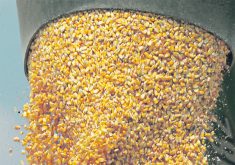Pork prices differ
There was a separation between the soaring futures market for hogs and pork last week and the cash market in the United States.
U.S. cash hog prices slipped early last week due to weaker retail demand, but then came back.
This was partly due to improved demand for pork and partly due to the weather-reduced hog supply in some areas.
Iowa-southern Minnesota hog prices (at plant mean, 51-52 percent lean, live equivalent) rose to $48.59 per hundredweight on March 16.
Read Also

Chinese, Indian tariffs take toll on pea prices
The disruption of pea exports from Canada’s largest customers will likely result in slow pea exports for the remainder of the crop year.
The week’s average hog price was 1.5 percent below the previous week’s level.
Futures traders responded to the reduction in European Union meat supplies and the import bans of EU meat to push hog futures prices higher.
April prices soared to post contract highs.
There was speculation that Japan would stop buying from Denmark and turn to American and Canadian suppliers.
Manitoba Agriculture said the hog market situation is volatile because if the potential Japanese ban of Danish pork does not occur, then traders will have to factor in domestic hog and pork market realities.
Although analysts acknowledge the disease problems in Europe could already have had a positive effect on the overall demand for North American pork, it remains to be seen how much additional pork will be required to fill the void.
It appears the Japanese have cut back their meat consumption and may not have to buy as much pork as originally anticipated, Manitoba Agriculture said.
Beef prices dropped
Fed steers averaged $4 per cwt. lower last week and heifers were down $1.50, said Canfax.
Although prices were lower to start the week, no further downside was apparent due to tight supplies.
There was light interest from American buyers.
Slaughter cows were $2 per cwt. lower on average due to increased slaughter cow volumes and significantly lower boneless beef prices.
Canfax advised that feedlots continue to sell cattle to stay current and keep front-end supplies under control.
Prices might edge slightly lower, but rising spring beef demand might help boost prices into April.
The Montreal wholesale beef price reflected early March’s fed cattle price gains and rose $5 per cwt. to $197-$198.
But the Calgary market reacted to the lower prices last week and handyweight steers fell by $1-$2 to $190-$200 per cwt. with regular heavyweights at $188-$190.
Volumes of feeder cattle going to market jumped in Alberta last week, pressuring averages down by $1-$3.
Calves were barely steady to $1 lower.
Canfax expects continued large volumes will keep prices under pressure until feeders can start placements destined for the stronger late summer, early fall fed market.
Calf prices are not expected to be under much pressure. Canfax said the spectre of drought in southern areas is starting to work into the market. If it stays dry, it would mean increased feeder sales volumes.
Stock cow bred sales were steady last week.
Bred cows sold from $700-$1,600 (most trading at $1,100-$1400), with bred heifers trading in a range of $1,000-$1,600 (most sales $1,150-$1,500). Cow-calf pairs sold from $1,175-$1,700.
The U.S. March 1 seven-state cattle-on-feed report showed lower than expected marketings, which is considered price depressing for the April futures contract.
But the lower than anticipated placements are expected to boost prices in later month contracts.














